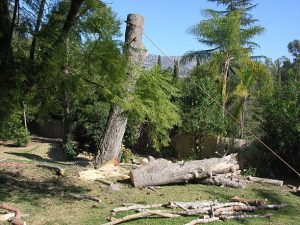Palm tree removal has many benefits, and the process is effective for the environment and your personal health. Here are a few: Lessens the risk of fire, Reduces CO2 emissions, and Promotes aesthetics. Read on to learn about these benefits and how you can decide to get rid of your palm trees. And remember that palm trees are a hazard!
 Lessens the risk of fire
Lessens the risk of fire
These trees can be dangerous to power lines because dead fronds may be carried by high winds and strike the lines, causing a fire. To lessen the fire risk, the utility company will trim palm trees up to four times a year. The work starts to give property owners time to remove palm trees. The contractors will post a notice of fire risk.
Palm trees are a potential fire hazard. Their stately trunks and thick flowery fronds liven up the urban landscape and create a tropical atmosphere. However, they can also become a fire hazard. A single palm tree can ignite and spread deadly fire in minutes.
Promotes better health
There are several benefits of palm tree removal from palmtreeremovaladelaide.com.au for better health. For starters, they reduce the impact on your property. A recent study found that residents near trees report better overall health. People who live in neighbourhoods where trees have been removed report higher rates of cardiovascular disease. The loss of trees also increases the risk of cardiovascular disease among women. Fortunately, there are solutions to these problems. One such solution is using neem oil, which is non-toxic to humans and pets. This oil is effective at killing insects by suffocation.
Palm trees shed their fronds naturally, and some species will drop them after some time. However, many palms require the fronds to provide nutrition for the plant, and removing them deprives the palm of essential nutrients. They also weaken the palm’s natural defences against invasive moulds. Moreover, allowing palm species to self-prune is beneficial for the health of the palm, as it is more likely to recover and flourish in its current state.
Another benefit of palm tree removal for better health is eliminating a hazard for people and property. Palm trees accumulate dead fronds, which can be extremely heavy. If they don’t fall off, these fronds can trap people in them and become a fire hazard. This can also be dangerous for people in the neighbourhood. Hence, removing the dead fronds as regularly as possible is important.
Reduces CO2 emissions
The palm family is an example of a large, diverse plant family that can be used in various products. Depending on the species, the impact of harvesting palm wood on the environment can vary greatly. Cutting down palm trees requires electricity to run sawing machines; that energy is also burned to make furniture. Illegal logging of palm forests in the Amazon and parts of Southeast Asia is a major problem, and consumers are encouraged to seek out sustainably harvested wood.
The BAU scenario accounts for approximately 40% of the total emissions from oil palm. However, excluding oil palm from forests reduces net carbon emissions by three to four per cent. Restoring secondary and logged forests reduces emissions by one to six per cent. In the BAU scenario, peatland deforestation and draining are responsible for thirty-six to forty-two per cent of emissions. While these carbon reductions may not sound impressive, they are still important to the palm-tree industry’s overall emissions.
While oil palm trees do not do a very good job sequestering carbon, they still absorb carbon when growing. The trees in the forests are capable of absorbing more than half of the carbon in the atmosphere than they absorb. While new oil palm plantations aren’t as efficient as a natural regenerating forest, they still store between fifty and ninety per cent less CO2 than the original forest cover.
In Malaysia, despite the high carbon footprint of palm trees, the trees are important for ecosystem health. And they provide valuable habitat for birds, bromeliads, and mosses. They do not sequester carbon like other tree species, and it is highly unlikely that palms will remain in the public realm after 2050. But the fact is that this palm species is so important that their replacements should make up only 25% of the city’s public trees.
Promotes aesthetics
The palm family consists of numerous species of tropical trees and shrubs. They differ from other trees in their large, compound evergreen leaves, called fronds. These leaves are arranged at the top of a stem with no branches and are highly distinctive and beautiful.